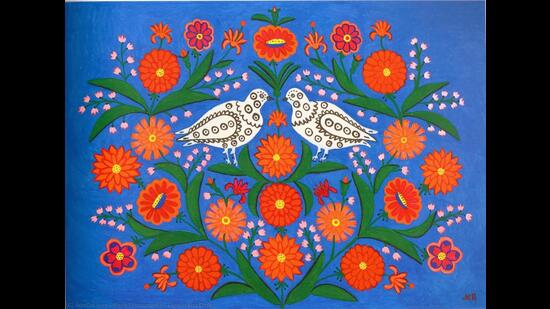When the Ivankiv local history museum in Ukraine caught fire under Russian bombardment amid the ongoing Russia-Ukraine war, earlier this year, a local reportedly risked his life to rescue 25 works displayed at the museum. The artworks on display were by late folk artist, Maria Prymachenko. This incident aptly describes the influence Prymachenko’s work has had over the lives and culture of Ukrainian nationals. Bringing 11 of her works to the Capital, through digital reprints is an exhibition, The Ukrainian World of Maria Prymachenko.
The Ukrainian folk-art painter was a self-taught artist who worked in the naïve art style. Her works, which also included embroidery and painting on ceramics, drew from local mythology and folklore, making her an icon of Ukrainian national identity. The show will include 11 reproductions of Prymachenko’s paintings from the collection of National Museum of Ukrainian Folk Decorative Art with text by artist Dorota Pietrzyk.

“The project was initiated by the National Centre for Culture of Poland in collaboration with the National Museum of Ukrainian Folk Decorative Art to preserve the destroyed art of Ivankiv local history museum, as well as to present abroad the works of world-famous Ukrainian artist,” says Olena Ivanchuk, consul at Embassy of Ukraine in New Delhi, adding, “The artworks have been selected in such a way as to give an idea of the diversity of her art as well as to demonstrate scenes from Ukrainian traditional life. The selected works, painted between the years 1963 and 1988, present an incredibly colourful world full of fantasy, filled with strange creatures, animals, floral motifs, as well as scenes from fairy tales.”
The sublime creations on display portray mystical birds, beasts and plants, which interact in her paintings just as harmoniously and easily as they do in natural surroundings in Ukrainian mythology. While Prymachenko’s works are full of folk ornamentations painted using rudimentary water-based paints, such as the so-called tempera for beginners, towards the end of her life that she shifted to more expensive and better quality tempera paints. Sharing how her works kept evolving further, Ivanchuk explains, “From the beginning of the ’60s, the size of Prymachenko’s works became enlarged. From translucent watercolours, the artist turned to thick saturated gouache, which in her works gives rise to sonorous magic-sounding colours and images. In the late 1960s, a novelty essential for her creativity appeared: pictures complemented with text captions and peculiar explanations. They opened another aspect of the artist’s talent — poetic.”

As the artist’s country goes through turmoil of war, Prymachenko’s bright and childlike depictions of scenes from daily life, such as farmers tending crops and plowing fields, provide a sense of hope and harmony. Ivanchuk says, “Preserving the culture is the same as preserving the soul of the nation. Prymachenko’s works are part of the cultural heritage of Ukraine, which presents Ukrainian mentality and traditions, creating a certain image of the Ukrainian nation. That’s why it’s so important for us to show Prymachenko’s paintings abroad. The exposition was originally designed to create a feeling of being home for Ukrainian refugees, who had to flee Ukraine due to the war.”
Catch It Live
What: The Ukrainian World of Maria Prymachenko
Where: India International Centre, Lodhi Road
On till: August 18
Timing: 11am to 7pm
Nearest Metro Station: Jorbagh on the Yellow Line
Author tweets @later_gaytor
Follow more stories on Facebook and Twitter
Stay connected with us on social media platform for instant update click here to join our Twitter, & Facebook
We are now on Telegram. Click here to join our channel (@TechiUpdate) and stay updated with the latest Technology headlines.
For all the latest Art-Culture News Click Here
